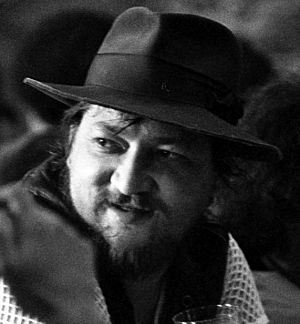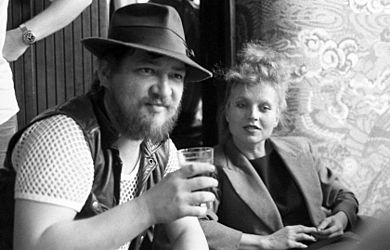Rainer Werner Fassbinder facts for kids
Quick facts for kids
Rainer Werner Fassbinder
|
|
|---|---|

Fassbinder in 1980
|
|
| Born | 31 May 1945 Bad Wörishofen, Bavaria, Allied-occupied Germany
|
| Died | 10 June 1982 (aged 37) |
| Resting place | Bogenhausener Friedhof, Munich |
| Occupation |
|
| Years active | 1965–1982 |
| Movement | New German Cinema |
| Spouse(s) |
Ingrid Caven
(m. 1970; div. 1972) |
Rainer Werner Fassbinder (31 May 1945 – 10 June 1982) was a German filmmaker. He is known as one of the most important people in the New German Cinema movement.
Fassbinder's films often explored how feelings can be used by others. His movies showed life in Germany after World War II, including its economic growth and political challenges. He also focused on themes like love, friendship, and how people connect with each other.
His first full-length movie was a gangster film called Love Is Colder Than Death (1969). He became famous in Germany with The Merchant of Four Seasons (1972). His first international success was Ali: Fear Eats the Soul (1974). Both are seen as great films by critics today. Later, he made bigger movies like Despair (1978), Lili Marleen, and Lola (both 1981).
His biggest success was The Marriage of Maria Braun (1979). This film tells the story of a German woman's life after World War II.
Fassbinder died on 10 June 1982, when he was 37 years old. His career lasted less than 20 years, but he made many films. He completed over 40 feature films, two TV series, three short films, and 24 plays. He won five major film awards in Germany, including the Golden Bear. His death marked a significant moment for the New German Cinema.
Early Life and Interests
Fassbinder was born in Bad Wörishofen, Germany, on 31 May 1945. This was just a few weeks after World War II ended in Europe. The effects of the war deeply influenced his childhood and family life.
His parents, Liselotte Pempeit (a translator) and Helmut Fassbinder (a doctor), divorced in 1951. His mother raised him in Munich. To earn money, she rented rooms in their home and worked as a translator. When she was busy, she often sent Rainer to the cinema. Fassbinder later said he watched at least one film every day, sometimes even four. This early love for movies shaped his future career.
As a teenager, Fassbinder went to boarding school. He often tried to run away and left school before finishing his exams. At 15, he moved to Cologne with his father. There, he started writing poems, short plays, and stories.
Starting His Career
In 1963, at age 18, Fassbinder moved back to Munich. He planned to study drama. He took acting lessons and attended an acting studio from 1964 to 1966. There, he met Hanna Schygulla, who would become one of his most important actors. During this time, he made his first short films and worked in theater.
He tried to get into the Berlin Film School but was not accepted. He then returned to Munich and continued writing. He made two more short films, The City Tramp (1966) and The Little Chaos (1967). His mother, Lilo Pempeit, acted in The Little Chaos, which was the first of many roles she would play in his films.
Theater Work
In 1967, Fassbinder joined a theater group in Munich called the Action-Theater. He acted, directed, and wrote plays. After two months, he became the leader of the theater. In 1968, he directed his play Katzelmacher. This play was about a foreign worker from Greece who faces hatred.
Soon after, the Action-Theater closed. But it quickly reopened as the Anti-Theater, with Fassbinder as the director. This group of young actors, including Fassbinder, Hanna Schygulla, and Irm Hermann, lived and worked together. They became a key part of his film crew later on. Fassbinder wrote, directed, and acted in many plays with the Anti-Theater. In 18 months, he directed 12 plays.
His theater directing style was similar to his early films. It mixed planned movements with still poses, taking ideas from musicals, cabaret, and films.
After making his first feature films in 1969, Fassbinder focused more on being a film director. However, he still worked in theater until his death. He also made several radio plays in the early 1970s.
Early Films and Recognition
Fassbinder used his theater experience to make films. Many actors and crew from the Anti-Theater worked with him throughout his career. For example, he made 20 films each with actresses Hanna Schygulla and Irm Hermann. He was inspired by the French New Wave cinema and directors like Jean-Luc Godard. He also admired The Damned (1969) by Luchino Visconti.
Fassbinder developed quick ways of working. Because he knew his actors and crew so well, he could make four or five films a year with very small budgets. This helped him get government funding to keep making movies.
Unlike other famous German directors, Fassbinder's theater background was clear in his films. He learned how to handle all parts of filmmaking, from writing and acting to directing and managing. He also worked as a composer, production designer, cinematographer, producer, and editor on his films. He even acted in 30 films for other directors.
By 1976, Fassbinder was known around the world. He won awards at major film festivals, and his films were shown in Paris, New York, and Los Angeles. This made him a well-known name among film lovers. His films became popular in art house cinemas after Ali: Fear Eats the Soul gained international fame. In 1977, he was a judge at the 27th Berlin International Film Festival.
Film Career Highlights
Starting at age 21, Fassbinder made 44 films and TV dramas in 15 years. He also directed 15 plays. He wrote or adapted most of his films for the screen. He often worked as an art director, editor, and acted in 19 of his own films. He wrote 14 plays and directed 25 stage plays. He also wrote and directed four radio plays. He worked quickly, often skipping rehearsals and using the first take.
His first ten films (1969–1971) were like an extension of his theater work. They often used a still camera and dialogue that sounded a bit unnatural.
From 1971 to 1977, his films gained international attention. These films were often inspired by the melodramas Douglas Sirk made in Hollywood in the 1950s. In these movies, Fassbinder explored how deep-rooted biases about race, gender, and social class exist in society. He also looked at the everyday challenges within family life and friendships.
His final films, from 1977 until his death, were more varied. He sometimes used international actors and changed his regular cast. He explored different plots, styles, and subjects in films like The Marriage of Maria Braun (1979), The Third Generation (1979), and Querelle (1982). He also explored themes in middle-class settings with his trilogy about women in post-fascist Germany: The Marriage of Maria Braun (1979), The Angst of Veronica Voss, and Lola.
Fassbinder once said, "I would like to build a house with my films. Some are the cellars, others the walls, still others the windows. But I hope in the end it will be a house."
His work was honored in a 2007 exhibition called Fassbinder: Berlin Alexanderplatz.
Personal Life
Fassbinder often mixed his work and personal life. He was known for casting family and friends in his films.
Death
Fassbinder died on 10 June 1982. He is buried in the Bogenhausener Friedhof in Munich.
Filmography
- Love Is Colder Than Death (1969)
- Katzelmacher (1969)
- Gods of the Plague (1970)
- Why Does Herr R. Run Amok? (1970)
- The American Soldier (1970)
- The Niklashausen Journey (1970)
- Baal (1970)
- Rio das Mortes (1970)
- Mathias Kneissl (1971)
- Whity (1971)
- The Merchant of Four Seasons (1972)
- The Bitter Tears of Petra von Kant (1972)
- Eight Hours Don't Make a Day (1972–1973)
- The Tenderness of Wolves (1973)
- World on a Wire (1973)
- Ali: Fear Eats the Soul (1974)
- Martha (1974)
- Effi Briest (1974)
- Fox and His Friends (1975)
- Mother Küsters' Trip to Heaven (1975)
- Shadow of Angels (1976)
- I Only Want You to Love Me (1976)
- Satan's Brew (1976)
- Chinese Roulette (1976)
- The Stationmaster's Wife (1977)
- Germany in Autumn (1978)
- Despair (1978)
- In a Year of 13 Moons (1978)
- The Marriage of Maria Braun (1979)
- The Third Generation (1979)
- Berlin Alexanderplatz (1980)
- Lili Marleen (1981)
- Lola (1981)
- Veronika Voss (1982)
- Kamikaze 1989 (1982)
- Querelle (1982)
Plays
- 1965: Nur eine Scheibe Brot
- 1966: Tropfen auf heiße Steine (filmed in 2000 as Gouttes d'eau sur pierres brûlantes)
- 1968: Katzelmacher (filmed by Fassbinder 1969)
- 1968: Der amerikanische Soldat (filmed by Fassbinder 1970)
- 1969: Preparadise sorry now
- 1969: Anarchie in Bayern
- 1969: Gewidmet Rosa von Praunheim
- 1969: Das Kaffeehaus (based on Carlo Goldoni's La bottega del caffè, filmed by Fassbinder 1970)
- 1969: Werwolf
- 1970: Das brennende Dorf (based on Fuente Ovejuna by Lope de Vega)
- 1971: Blut am Hals der Katze
- 1971: Die bitteren Tränen der Petra von Kant (filmed by Fassbinder 1972)
- 1971: Bremer Freiheit (based on the case of Gesche Gottfried, filmed by Fassbinder 1972)
- 1973: Bibi (based on the play Bibi - Seine Jugend in drei Akten by Heinrich Mann)
- 1975: Der Müll, die Stadt und der Tod (filmed in 1976 as Schatten der Engel)
Images for kids
See also
 In Spanish: Rainer Werner Fassbinder para niños
In Spanish: Rainer Werner Fassbinder para niños






